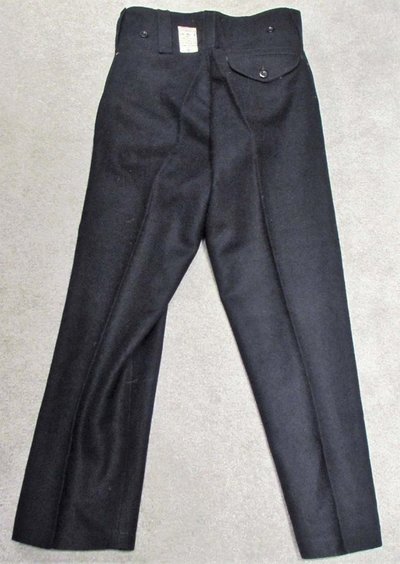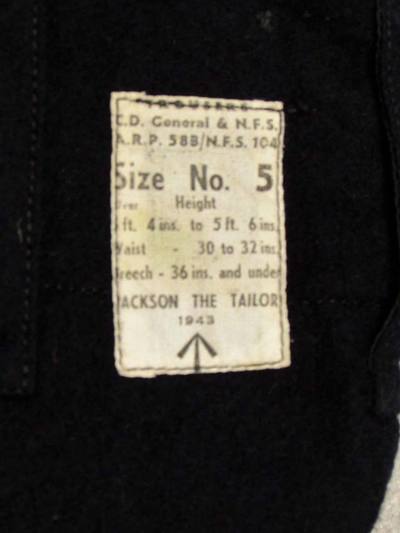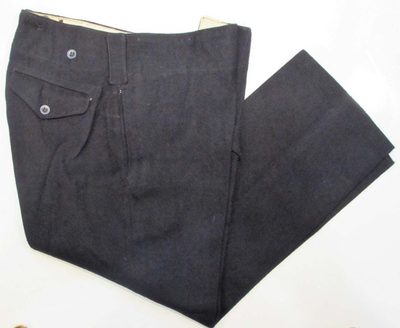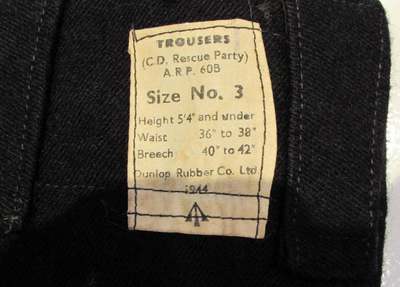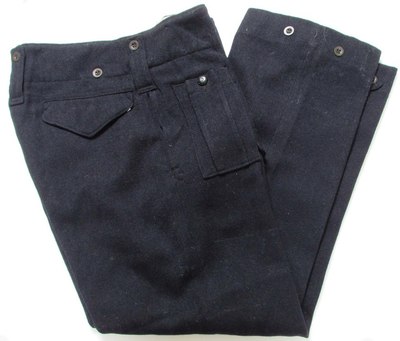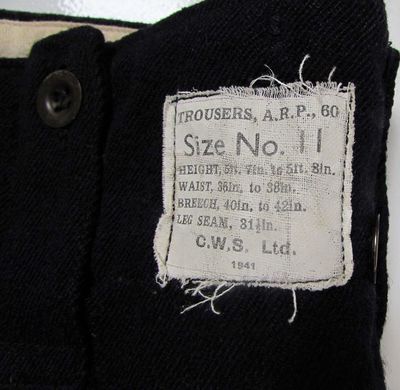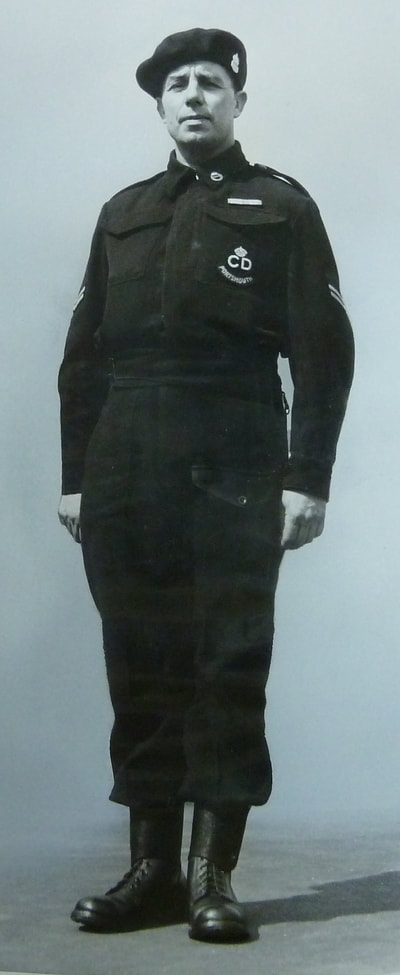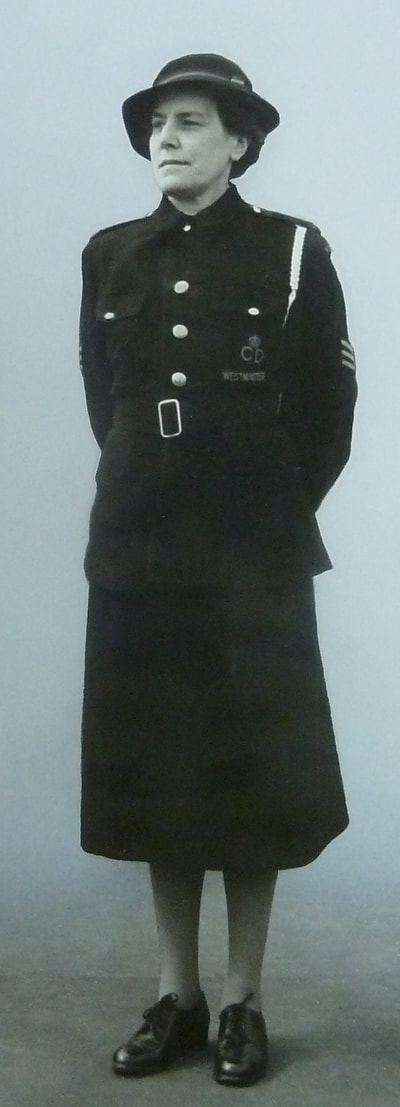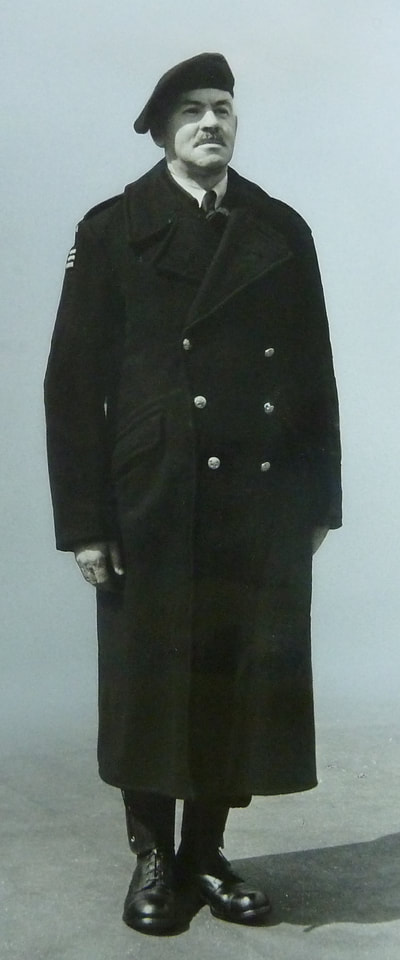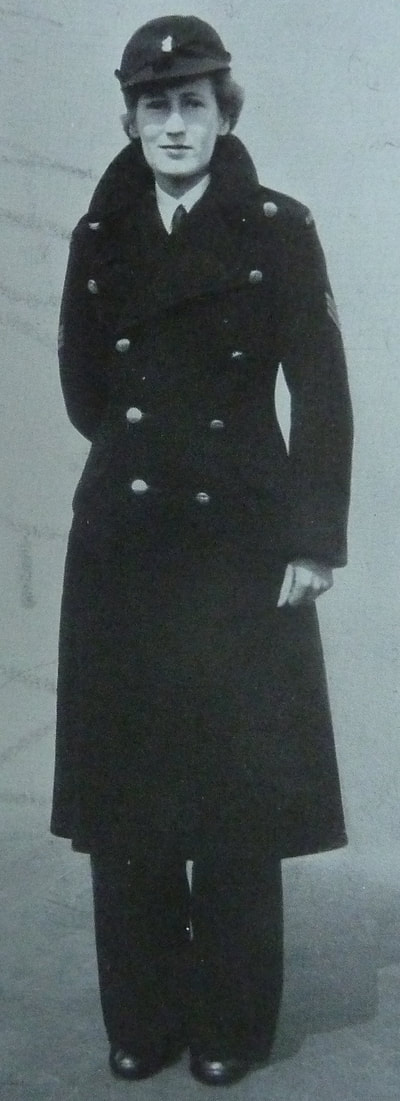WW2 Civil Defence / ARP Battledress & Trousers
Battledress (BD) Blouse - ARP Pattern 57, 59 & 59A
|
Issued first to First Aid and Rescue Parties in February 1941, the very dark blue serge ARP Pattern 59 Battledress Blouse (Rescue) and ARP Pattern 60 Battledress Trousers (Rescue) were of an identical cut to the Army pattern BD. In July of 1941, the same two-part uniform was issued to men in other Civil Defence services (ARP Pattern 57 Battledress Blouse and ARP Pattern 58 Trousers made of a slightly lighter weight cloth). Regulations stipulated that junior ranks wore the BD with the neck closed. Senior ranks could wear the jacket open at the neck with a light-coloured shirt and dark blue or black tie.
A wool beret (ARP Pattern 68) was also available to which most attached their silver ARP badge. For newcomers to the Civil Defence services a base metal ARP badge was manufactured during the war until replaced with a small embroidered CD badge (ARP Pattern 98) similar in design to the CD breast badge for the beret. |
Two distinct battledress patterns were issued, easily identified by the exposed buttons on the later jackets. Buttons on the austerity versions have the central closure and breast pockets exposed; also an 'A' was added to the ARP Pattern label and appeared from mid-1942 (see below).
The markings from the War Department found stamped in white or inked onto the manufacturer label relate to the year made: P=1941 O=1942 N=1943 M=1944 L=1945. The epaulette buttons were unmarked black plastic revolving shank buttons or four-hole plastic dish buttons (later post-war blouses often have small black CD and crown buttons). See a list of all uniform sizes.
The markings from the War Department found stamped in white or inked onto the manufacturer label relate to the year made: P=1941 O=1942 N=1943 M=1944 L=1945. The epaulette buttons were unmarked black plastic revolving shank buttons or four-hole plastic dish buttons (later post-war blouses often have small black CD and crown buttons). See a list of all uniform sizes.
The battledress jacket/blouse featured two large breast pockets with pocket flaps (but without pleats) and two internal pockets. Early versions of the battledress blouse featured metal four-hole dish buttons painted black on the front opening. Later versions had plastic buttons for economy reasons. The neck could be fastened with a hook and eye at the throat. Epaulettes on each shoulder had a revolving shank plain black plastic button (on some austerity battledress all the buttons are of this type).
The waist had a buckle fastening that allowed for some adjustment. It should be noted that the buckles for tightening at the waist come in various designs: from a very simple slide loop to buckles with toothed sliders for grabbing onto the serge. The edges of the jacket pockets were lined with grey (sometimes blue) cotton drill. The jacket could be buttoned at the rear to the battledress trousers via two buttons on the trousers.
For more information on ranks see this page.
The waist had a buckle fastening that allowed for some adjustment. It should be noted that the buckles for tightening at the waist come in various designs: from a very simple slide loop to buckles with toothed sliders for grabbing onto the serge. The edges of the jacket pockets were lined with grey (sometimes blue) cotton drill. The jacket could be buttoned at the rear to the battledress trousers via two buttons on the trousers.
For more information on ranks see this page.
ARP Pattern 57A Austerity Battledress Blouse
The austerity pattern blouse (also issued to NFS (National Fire Service personnel). Easily denoted by the exposed buttons to pockets and front closure.
ARP Pattern 59A Rescue Party Austerity Battledress Blouse
The Rescue Party austerity blouse was similar to the ARP Pattern 59A but the wool was of a higher quality. It was assumed that rescue parties put their uniforms under more stress and use. The below blouse is 1944 dated.
WW2 Female Civil Defence Battledress Blouse
During the war, no battledress jackets were made for women. However, there exist a number of photographs showing women wearing a man's battledress. See this blog post for an example.
The post-war Civil Defence Corps introduced battledress designed specifically for women.
The post-war Civil Defence Corps introduced battledress designed specifically for women.
Battledress Trousers - ARP Pattern 58, 58A, 58B, 60 & 60B
 Battldress trousers worn by a FAP volunteer
Battldress trousers worn by a FAP volunteer
Serge battledress trousers were manufactured to be worn with the battledress jacket. ARP Pattern 59 jackets were made for the Rescue Party services using a slightly heavier wool serge material to withstand the wear and tear of the duties that Rescue Parties were expected to undertake. The Rescue Parties also received slightly more robust trousers designated ARP Pattern 60 (these trousers have hem tabs at the bottom of the trousers for tightening around the ankle) and later ARP Pattern 60B trousers (minus the hem tabs).
ARP Pattern 58 trousers (and the later ARP Pattern 58A austerity pattern) were for general distribution across all Civil Defence services. The ARP Pattern 58B trousers were issued to Civil Defence General Services as well as the National Fire Service (NFS).
Much like the army battledress, the trousers featured two slant pockets, a rear buttoned pocket, a leg pocket on the left leg and a bandage pocket on the front right. Buttons on the rear waistband allowed the battledress blouse to be buttoned to the trousers.
ARP Pattern 58 trousers (and the later ARP Pattern 58A austerity pattern) were for general distribution across all Civil Defence services. The ARP Pattern 58B trousers were issued to Civil Defence General Services as well as the National Fire Service (NFS).
Much like the army battledress, the trousers featured two slant pockets, a rear buttoned pocket, a leg pocket on the left leg and a bandage pocket on the front right. Buttons on the rear waistband allowed the battledress blouse to be buttoned to the trousers.





